Welcome, all aspiring chefs and people who got here by complete accident. Knowing your kitchen knives is the mark of a professional chef, as well as an assassin. No matter which of these statuses you’re trying to achieve, it’s about time for you to discover all types of kitchen knives.
Not only will this make your work in the kitchen a lot more accessible, but it will also bless you with complete confidence when shopping for kitchen tools. For example, this will ensure you won’t buy a filleting knife to cut your filet mignon and that you don’t refer to a salmon knife as a “katana.”
I’ll cover all types of kitchen knives you may encounter and help you recognize them, pick the best quality ones, and use them for their God-granted purposes only. You will also find some neat tricks for caring for your knives at the end of this article and a rough guide on which of these you actually need in your kitchen.
Let’s begin – I don’t want to keep you on edge.
Table of contents
Multi-purpose knives
Chef’s knife
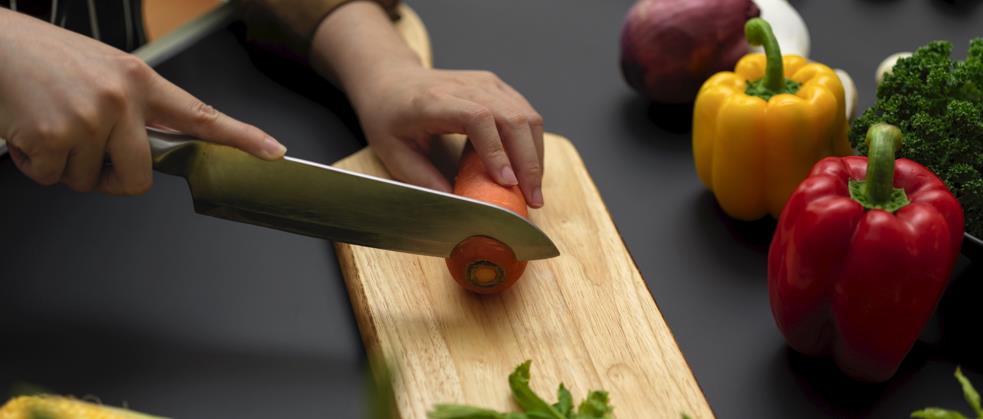
Starting with something easy, let’s talk about the classic chef’s knife for a second. You will find this knife in most kitchens due to its versatility. It has a long, broad blade with a straight edge. The blade’s widest part is the one closest to the heel, from which it tapers into a fine point.
It is meant to be rocked back and forth on the cutting board, allowing you to chop and dice many vegetables at once. Due to its broad blade, it can sustain a lot of pressure, which makes it perfect for cutting harder foods, such as potatoes and parsnips.
How to Use a Chef Knife and Cook like a Pro
Santoku
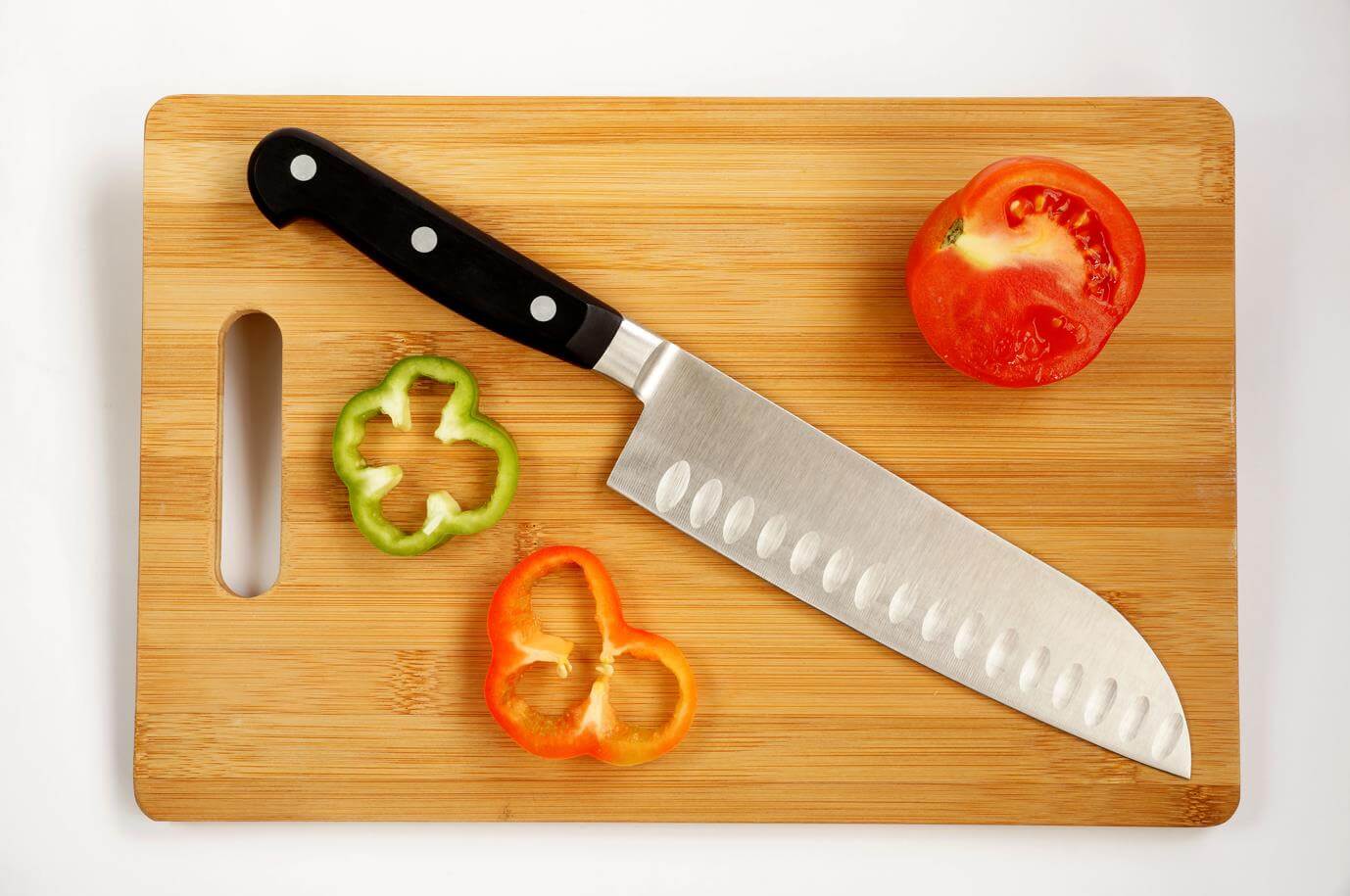
Santoku bocho translates into “three uses,” which refer to mincing, dicing, and slicing. These are a fancier version of the classic chef’s knives but feature a slighter curve of the edge with a sharp tip. This is due to their turned-down spine, which is called a sheep’s foot blade.
They are the kids of the traditional Japanese vegetable knife, which has a rectangular blade, and so they are great at creating thin slices. The indents on the sides of the blade make it easier to release each slice. You can use them for vegetables, meat, seafood, or cheese.
Santoku Knife Uses: Everything You Wanted to Know
Utility knife
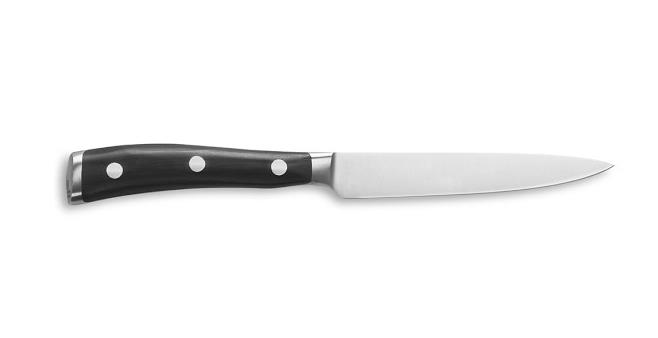
A utility knife is the pocket version of a chef’s knife. They look exactly the same, with the utility knife being a bit smaller and slimmer. Some even have a sharper tip, which tapers toward the spine for really intricate work. You can use this type of knife for cutting and dicing smaller fruit and veggies or for creating visual details on your food.
It is an excellent precision instrument that works perfectly for all jobs that your chef’s knife is too big to handle. Ever had a tomato rose? You can do that with a utility knife.
Utility Knife Uses – Kitchen Knife of All Trades
Serrated utility knife
A utility knife can also have a serrated cutting edge, the same as a bread knife. The serrated utility knife is a great helper when you need to take precisely cut foods with a thick or crusty outer layer – perfect for pastry, thick-skinned produce, and steak!
You might think that a bread knife would suffice, but the blade design and length are the main strengths of a serrated utility knife. At 4 to 6 inches of blade length, you can use a serrated utility knife to cut various foods comfortably without shredding or tearing them.
Serrated Utility Knife Uses for Perfect Cuts Every Time
Utility knife vs. chef knife
A chef’s knife is suitable for many cutting tasks. Undoubtedly, it’s the most versatile blade for most cooks. You can think of the utility knife as a smaller version of this all-purpose kitchen knife.
Using a utility knife is more comfortable for cutting ingredients appropriate for its size. It’s the best equivalent to the chef’s knife if it feels too big for what you have in front of you or your hands.
Similarly, the utility knife can be small for your cutting needs. Take the chef’s knife for mincing, halving squash, and other general cutting needs. Leave the utility knife for precision tasks when cutting small ingredients.
Utility Knife vs Chef Knife – What’s the Diff?
Chinese cleaver
Don’t let its name deceive you; the Chinese cleaver is a highly adaptable kitchen knife – and no – it isn’t used for cleaving bones. Also known as Cai Dao, the Chinese cleaver is mainly for slicing, dicing, and mincing vegetables.
The Chinese cleaver doesn’t feature a thick spine like typical cleavers. It has a rectangular design with a rather heavy blade that aids in cutting. The beefy blade is perfect for scooping chopped goods from the cutting board.
Chinese Cleaver: Features, Uses, Care and Storage
Handpicked multi-purpose knives for you
True cutting power in the palm of your hand
Butcher knives
Cleaver
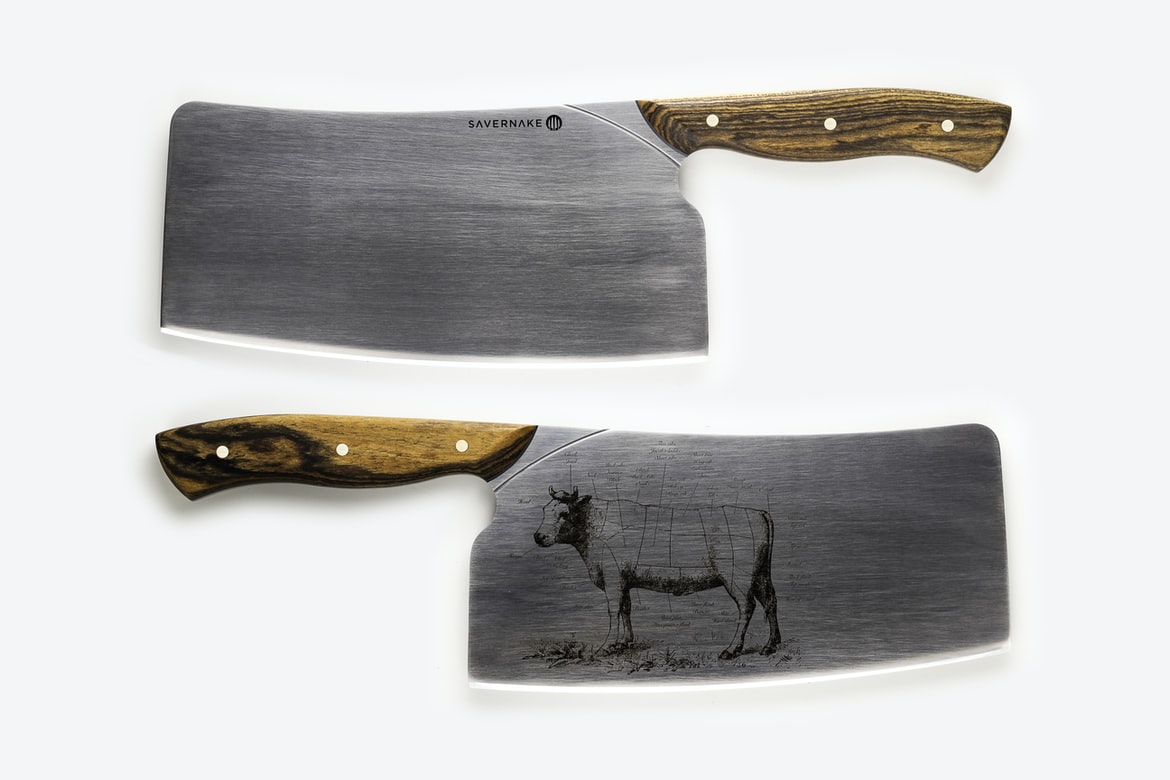
Cleavers are the tools you need when you work with a lot of meat or when directing a horror flick. They have a flat, rectangular blade, and they come in a lot of sizes to accommodate many different uses. Their large, heavy designs make it easy to cut through raw meat and even bones. This is why they are the best tool for chopping up the meat into cooking portions. And this is also why they are called butcher’s knives.
5 Proven Cleaver Uses You Can Try Today
Boning knife
Boning knives are not as helpful during the butchering process, but they are invaluable for your traditional kitchen. They feature a long, slim blade that ends into a sharp tip. The blade is usually somewhat rigid, although you can find more flexible options for more delicate meats.
It is supposed to help you cut through smaller bones and cartilage, detach the meat from its bones and trim away your cut before cooking.
Top 5 Amazing Boning Knife Uses
Slicing knife
The slicing knife has many variations, but the typical design features a long, thin, and flexible blade. Some feature a rounded end; some have a pointy tip. The stabby tip is handy for making slits before slicing. The ones with a rounded end often have a straight edge, allowing you to have even slices as the blade doesn’t taper down.
Slicing Knife Uses: How to Choose, Use, and Care
Ham knife
A ham knife is for cutting ham and other cured meats. It’s a specialized version of the slicing knife with a similar blade profile having a round end – often featuring a Granton edge. This addition to the ham knife prevents the slices from sticking, ensuring each cut is tear-free.
These knives are long, at 8 to 14 inches. This blade length enables the user to make slices from heel to tip in one go. You won’t need to move the ham knife back and forth, not creating traction and getting smooth cuts. Additionally, you can get a ham knife with serrated, pitted, or scalloped edges.
The Ultimate Guide to Ham Knife
Carving knife
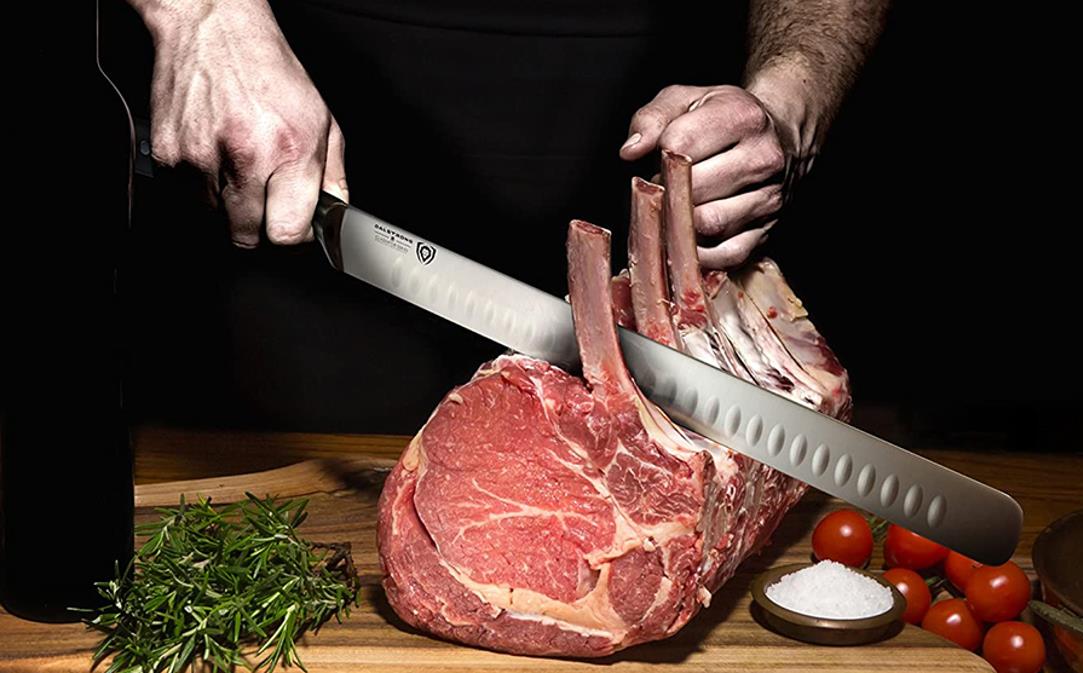
Carving knives are more niche but absolutely vital if you take pride in your beef roasts. However, they have a long, straight, narrow blade that ends in a rounded point – so they are probably not great for assassins.
They come in handy after cooking large cuts of beef, pork, or even turkey, and they make carving slices very easy. The blade features long indents on each side, so each slice is quickly released. They are a great addition to your collection if you love slow-cooked roasts, but they can sometimes make vegans uncomfortable.
Slicing Knife vs Carving Knife: What’s the Difference?
Carving knife vs. chef knife
The carving knife has a specific use, while the chef’s knife is all-purpose cutlery. Many of the things you can do with a carving knife, you can do so with a chef’s knife.
However, this doesn’t make the chef’s knife better. It’s more leisurely to carve roasts, slice cured meats, and break down whole poultry with a carving knife. These are doable with a chef’s knife, but the thick heel can create unnecessary traction and tear the slices.
At the same time, using a carving knife to mince herbs or dicing potatoes to garnish roasts isn’t as appropriate. Every knife has its strengths and downsides. If you’re picking between the two, the adaptable nature of the chef’s knife will provide you with more uses, though the carved roasts may not look as presentable.
Carving Knife vs Chef Knife: What Are the Differences?
Carving knife vs. slicing knife
The carving knife and slicing knife looks almost identical. Both have an elongated blade profile. While the carving knife always has a pointed tip, the slicing knives can come with a rounded, dull end.
The main difference between the two that affect their uses is the blade thickness. The carving knife is thicker for increased sturdiness. This enables cooks to utilize it for cutting dense meats and separating the cooked meat from bones.
The slicing knife is thinner and often flexible. It serves you better when cutting soft foods, like boneless animal protein. The slicing knife is more suitable for simple slicing duties. The carving knife is more robust with its relatively thick spine. It can get around cartilage, separate meat from the bone like a boning knife, and carve dense meats.
Slicing Knife vs Carving Knife: What’s the Difference?
Vegetable knives
Nakiri
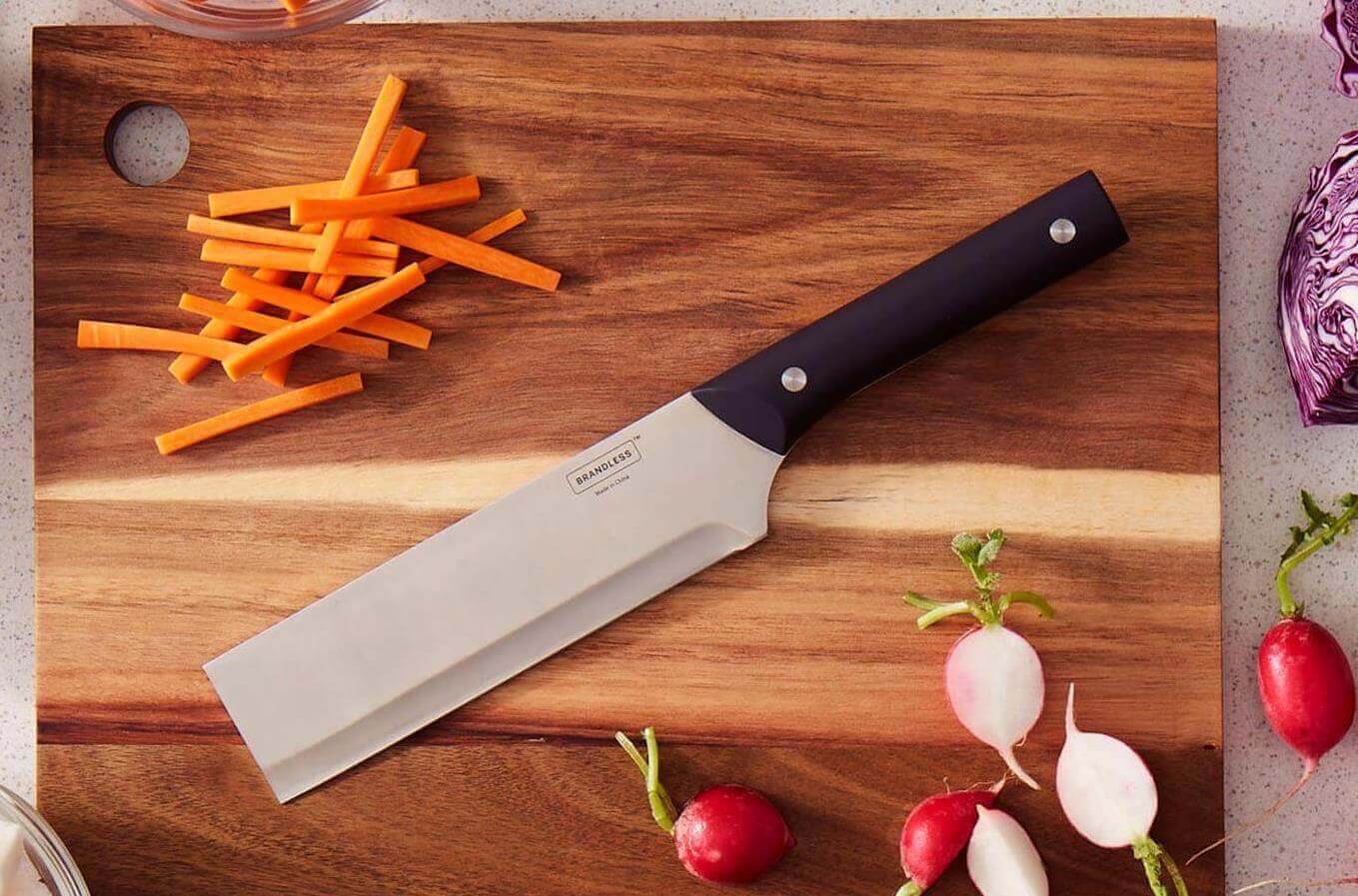
A Nakiri looks like a smaller meat cleaver, but it is used mainly for vegetables. In fact, “nakiri” literally translates to “veggie cutter.” The straight blade allows you to employ a lot of pressure, so you can use it for chopping the hardest vegetables with a lot of ease.
But don’t let its rugged looks fool you. This versatile knife can also be used for precision work, like mincing garlic and chopping herbs. So, if you don’t usually cook meat, this is probably the knife you need. Not to mention, you’ll look really cool handling it.
What Is a Nakiri Knife: The Only Veggie Slicer You Need
Tourne knife
A tourne knife is a specialized kitchen knife smaller than a paring knife. This knife is also known as the bird’s beak knife. There aren’t many uses of the tourne knife. It’s mainly used for making a tourne cut, a French cutting style to garnish dishes that resemble a football.
The tourne knife has a short blade at two inches with an inward curve at the tip. Other than turning vegetables into seven-sided shapes, the tourne knife is perfect for peeling rounded fruits and vegetables. The curved tip touches the entire peel, ensuring cooks can peel away the skin effortlessly without waste.
What Is a Tourné Knife?
Paring knife
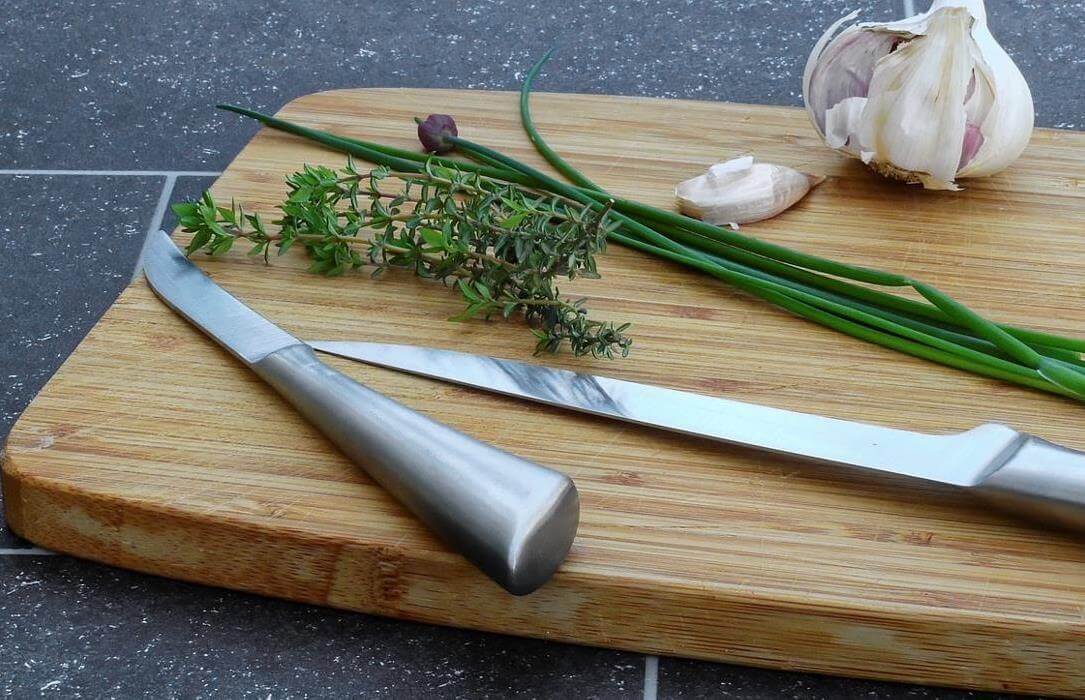
Paring knives are typically 3-4 inches long, and they are used for preparing small fruit and veggies. Their size allows for easy precision work, so they are great for creating intricacies and preparing garnishes.
They are also great for small peel jobs and removing outer layers from veggies and fruit. In fact, to pare means to cut away the outer surface. Plus, due to its small size, you can use this knife for many tasks around the house. Just remember to put it back when you’re finished.
What Is a Paring Knife and How to Use Is
Utility knife vs. paring knife
If we order these general-purpose kitchen knives by size, the chef’s knife would be at the top; the utility knife the second, and the paring knife the last.
When the chef’s knife seems overkill for certain ingredients, use a utility knife. When the utility knife is the same, use a paring knife. All three of these knives have numerous uses, but most cooks tend to skip the intermediary and pair their chef’s knife with a paring knife.
Let’s not undermine the benefits of a utility knife, though. It’s an excellent kitchen knife you can use for various cutting tasks. Whether it be halving a fruit, scoring vegetables to mince, or cutting shallots, the utility knife will serve you right. Its lengthy blade than a paring knife that’s still shorter than a chef’s knife services cooks in various ways.
Utility Knife vs Paring Knife: Ultimate Comparison
Fish knives
Fillet knife
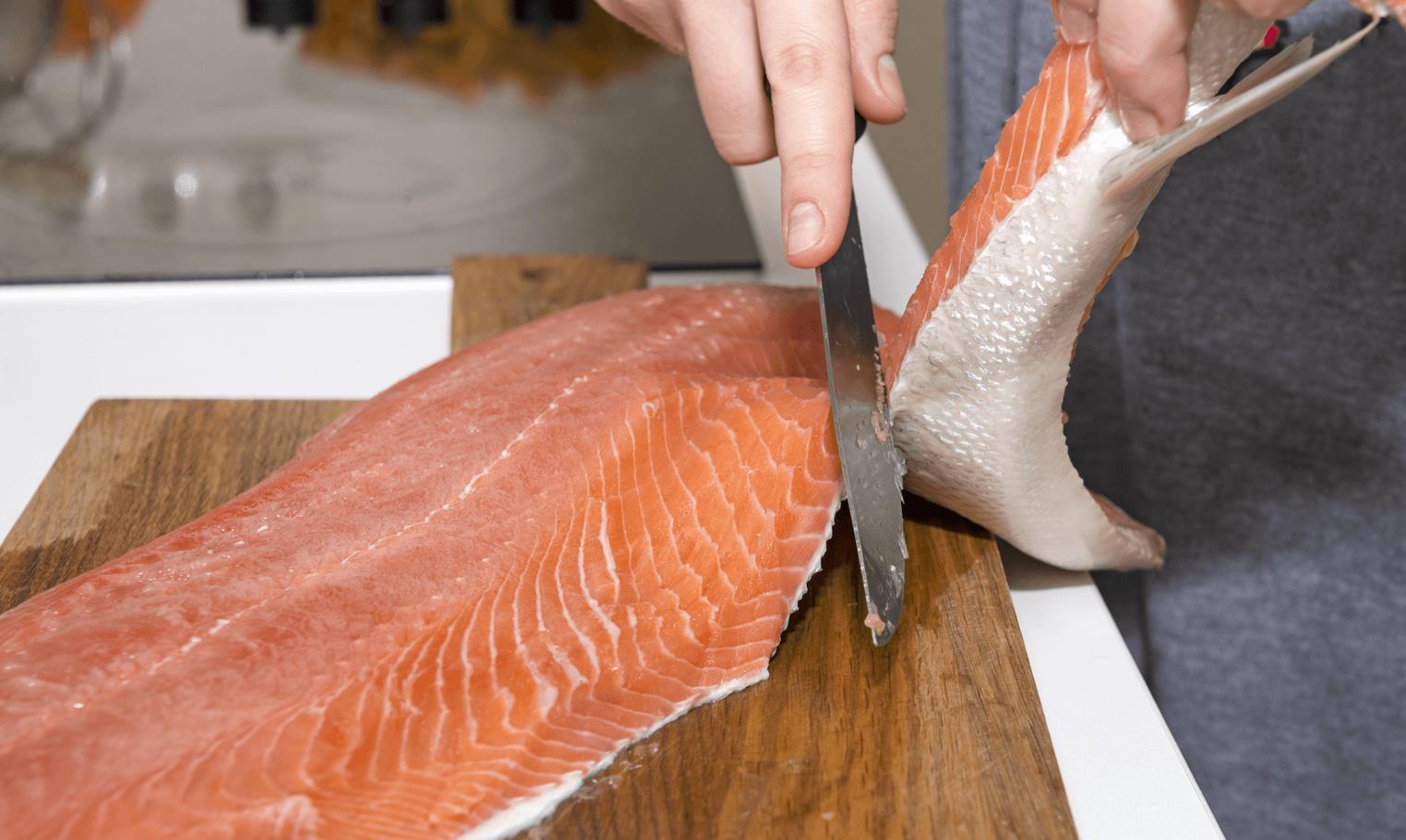
A fillet knife is the knife to have if you want to look like a ninja. They feature a trailing point blade and are made for slicing and skinning. A fillet knife is mainly used for skinning and deboning fish, but some have more rigid blades and can be used for delicate meat such as poultry. Their blades are long, narrow, and feature a very sharp point for easy puncturing. Their bevel is typically between 12 and 17 degrees, making for a razor-sharp edge. Needless to say, this is a knife you need to handle with precaution.
What Are the Main Fillet Knife Uses?
Filet knife vs. boning knife
With their similar blade profiles, putting a distinction between a filet knife and a boning knife without using them is hard. The filet knife is more flexible, but you can find similarly flexible boning knives.
Filet knives must be flexible, especially for fish. When moving the cutting edge right above the bone to separate the meat, the blade adjusts itself over the rough surface, giving you a beautiful filet in the end.
On the other hand, boning knives often don’t have the same flexibility. They debone meat and poultry better, though you can use them to filet an appropriately-sized fish when you don’t have anything better.
That said, a boning knife is more adaptable for other tasks than its primary use. If you’re looking for a knife to debone and filet, a boning knife will get you further. For cooks dealing with seafood more than meat and poultry, a filet knife is a more practical choice.
Boning Knife vs Fillet Knife: The Ultimate Kitchen Riddle
Salmon knife
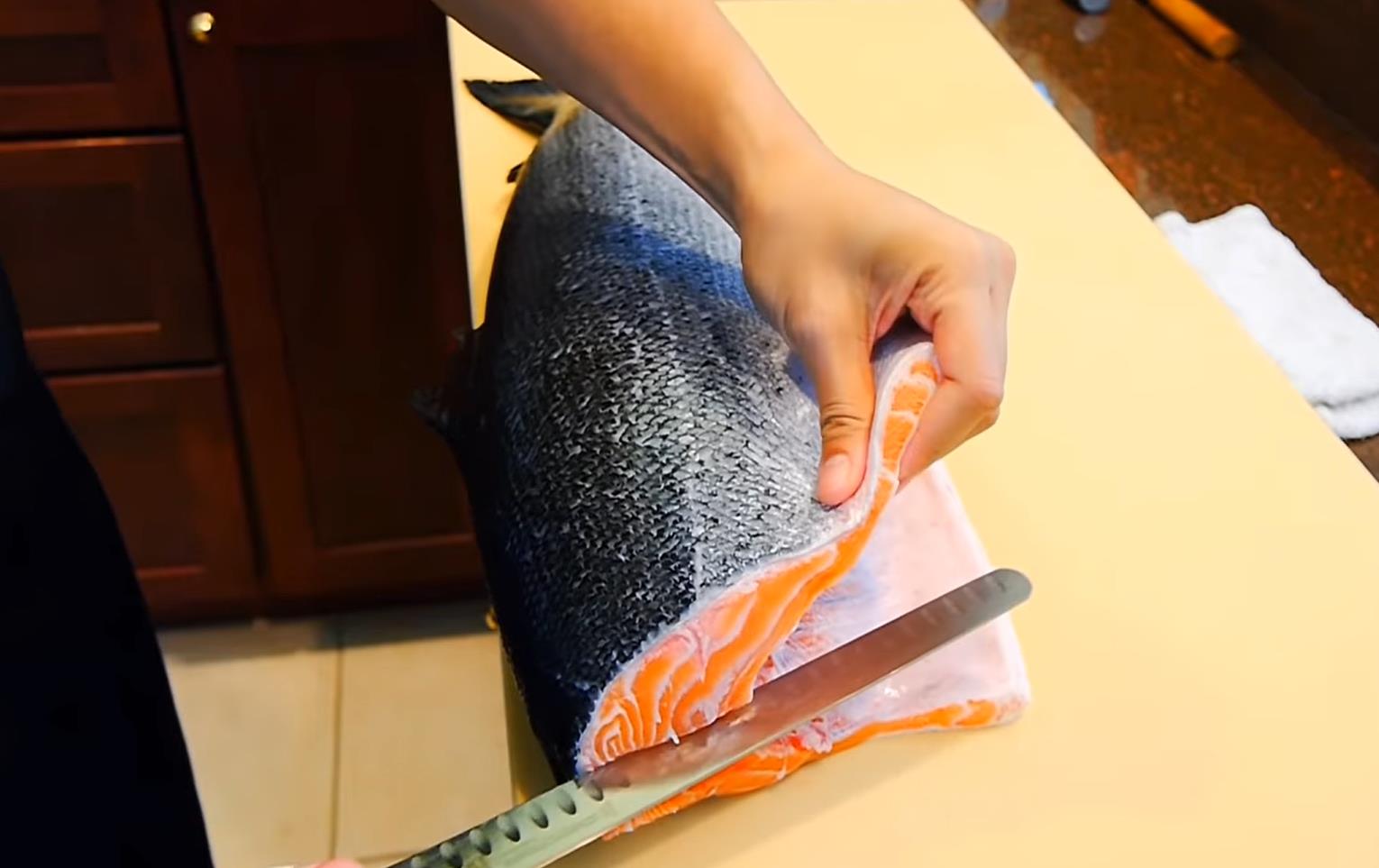
Salmon knives have really long, narrow, and flexible blades. Typically, they end in a rounded tip, but some feature a sharp point for puncturing. They are used for slicing and skinning larger fish, preponderantly salmon. Their flexible blade allows cutting of very thin, even slices of fish, but they can also be used for sectioning cakes and pastries.
Specialty knives
Bread knife | Cake knife
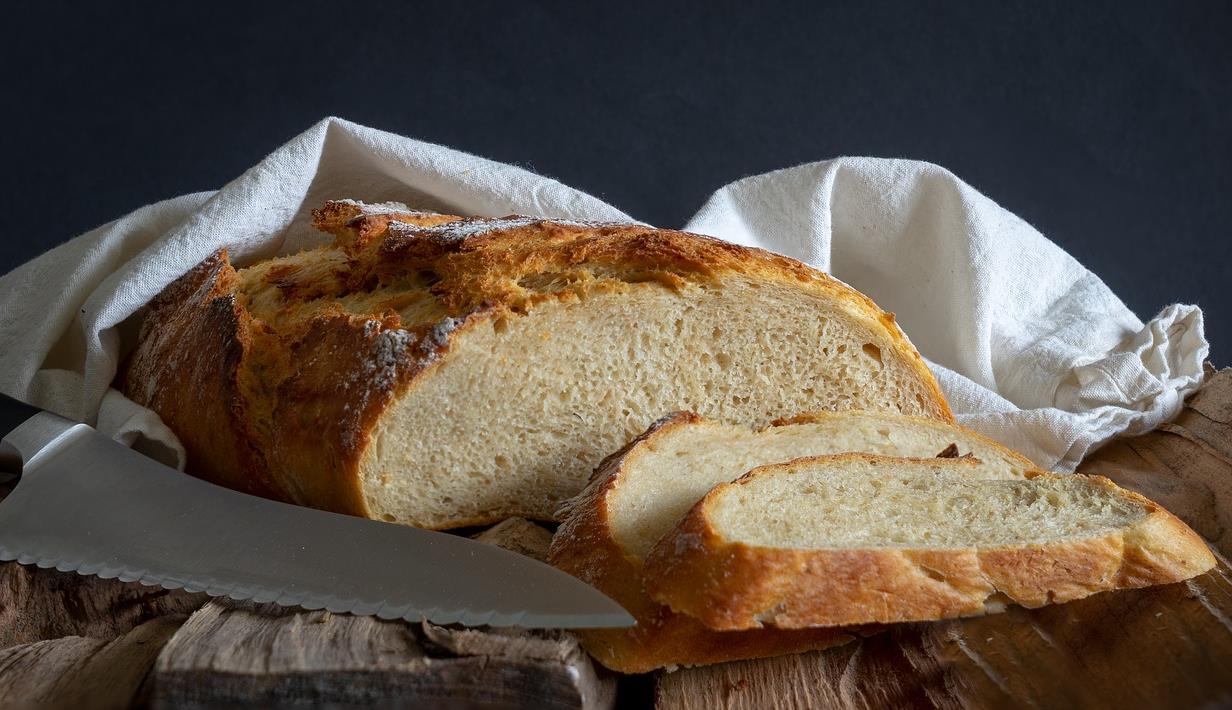
I’ll give you a second to guess what a bread knife is generally used for. Come on; there are no wrong answers. These knives have a straight, serrated edge that makes cutting soft bread and cakes, well, a piece of cake. It is also the perfect tool for shaping and leveling cakes for decorating, and it earns its place in the kitchen when dealing with tougher crusts.
You can recognize it by its specific shape, which looks like a Santoku knife with serrated teeth.
Bread Knife Uses – More Than Baked Goods
Steak knife
Steak knives can have a serrated edge like bread knives or a straight cutting edge. When sharp enough, both cut the meat well for tender bites.
However, many prefer serrated steak knives over non serrated ones. A non serrated steak knife can tear or shred the meat if it’s not sharp enough. A serrated steak knife getting the same amount of use as a non serrated one will stay sharper for much longer.
Although serrated steak knives don’t need sharpening as often, it’s tricky to bring their sharpness back to life. A small serrated knife is ideal for cutting steak, but it should never be used for cutting raw meat. The serrations will shred the fibers, leading to the meat losing moisture when cooking.
Serrated vs Non-serrated Steak Knives
Tomato knife
Can’t go a day without a thinly sliced tomato? Boy, do I have something in store for you. A tomato knife is a small, serrated knife that was engineered to perfection for slicing through tomatoes. Many of them feature forked tips that allow you to lift and move the slices after cutting. Its teeth make it easy to cut through the skin with minimal pressure, and its blades are perfectly proportioned for their use. What I mean is that they are tomato-sized.
Fluting knife
A fluting knife is more handle than knife, with a blade that typically ranges between 2 and 4 inches. It is a lot wider at the heel, then tapers into a very sharp point. It actually looks like a shorter, smaller version of a paring knife. And, coincidentally, they are used for the same purpose. You can use a fluting knife for delicate peeling and creating small, intricate garnishes.
Trimming knife
A trimming knife is a sleeker version of a fluting knife. It has a small, 2 to 3 inches long blade, but it is a lot more narrow and curved, reminiscent of a boning knife. It is generally used for trimming away excess fat, creating pockets in meats for stuffing, as well as everything else a fluting knife can do.
Cheese knife
Lastly, cheese knives come in a variety of shapes and sizes, but if you ever saw a tomato knife, you’ll have a deja vu with this one. It features a long, narrow blade that usually ends in a forked tip. You probably have the same number of cheese knife varieties as you have actual cheese types. Chisel knives, spreaders, cheese cleavers, soft cheese knives, parm knives, the possibilities are endless. And, to be honest, you can only use them for cheese plates. So you will only need one if you’re feeling exceptionally bourgeois.
Types of Cheese Knives: All You Need to Know
Kitchen Shears
I know shears are not considered knives by any means. But they do cut through food, and this is a comprehensive guide. They differ from regular scissors through their pivot point, which is further away from the handles and closer to the beginning of their short blades. Typically, they come with one or both serrated blades, and they are used to snipping herbs, cutting food packages, and breaking down poultry.
The Many Incredible Kitchen Shear Uses
What are the different knife features?
Think about some obscure use for a kitchen knife. Something you don’t imagine yourself ever needing. Well, someone probably thought about that first, and they probably also designed a knife for it. It’s pretty much impossible to analyze all the different knife features that you can find on the market, but here are some of the most common ones.
Parts of a knife – Source: Food Fire Friends
The blade is the part of the knife that is used for cutting. It is made of metal and usually continues into the handle. The extension is called a tang, and you will find full tang and partial tang knives.
The edge of a knife is the sharp, beveled side of the blade that you use for cutting. Next to the handle, it will have a small, dull section called a ricasso. It then continues into the sharpened edge, up until the point. The curve leading to the tip of the blade is called the belly.
The spine is the other side of the blade, which remains unsharpened.
The handle is the part where you grip the knife. It is made of various materials, such as plastic or rubber. You’ll find many types of handles that promote adherence, comfort, precision, etc.
The guard of a knife is located between the blade and the handle, with its main purpose being to prevent your hand from slipping onto the blade.
How to take care of your kitchen knives?
Sharpening
To keep your knives working their best, you will need to sharpen them regularly. Different types of knives come with different sharpening requirements, but all of them will require a bit of freshening up, once in a while.
There are many methods you can use for sharpening your knives, ranging from completely automated methods to painfully time-consuming (and satisfying) manual ones. Usually, you can make do with hand-held sharpening devices, but an electrical sharpener might be your saving grace if you have an extensive collection.
If you want to get fancy with it, you can use a whetstone. This will allow you complete control over the result, but you’ll need to get over the steep learning curve.
Generally, sharpening your tools every 1-2 months is advisable. You can preserve your knives in top condition by honing them every few days.
Cleaning
It’s generally a bad idea to clean your knives in the washing machine. You should strive to wash and immediately dry your knives manually, after every use. Depending on the material, some other precautions might be necessary, such as using mineral oil or wax to avoid stains and corrosion.
Yet, for the average knife, washing them with soapy, lukewarm water will generally do the trick. Just make sure to never leave them in the sink. Knives don’t need soaking, don’t cheat. Finish your chores.
Storing
Proper storage is vital to ensure your knives will serve you well for a really long time. You don’t want to leave them floating in a drawer, somewhere, as that’s the fastest way to damage the blades. And the easiest way to cut yourself.
Invest in a knife block or wooden drawer support that will keep your knives nicely tucked in and ready for the next meal.
Alternatively, you can get a magnetic strip to mount on your wall. This allows you to quickly see what available knives you have. And if you want to get really fancy, how about a knife roll? Guaranteed to turn some heads.
What knives do you actually need?
Even if you’re not wildly passionate about cooking, it’s really easy to start wanting to collect knives. I mean, if you didn’t need a different knife for any possible task you can do in a kitchen, then why do they make all of these knives?
In fact, I was really close to buying some extras just by writing this article. It’s a serious disease. But, in reality, you don’t need all of these types of cooking knives. In fact, you could make do with just a few of them.
In an attempt to save your wallet, we’ve made a table with the absolute necessities, along with some different kitchen knives that you might want to have around. You probably won’t notice not having them, but when you do, they might inspire you to try new things.
| Must-haves | Nice-to-haves |
| • Multi-purpose knife • Paring knife • Boning knife • Kitchen shears • Honing steel | • Meat cleaver • Utility knife • Serrated knife |
Final word
If you only take one thing from this article, it should be that you should probably steer clear of kitchen knives sets. They usually come with many options you don’t really need, and we all know that simplicity is the way to go in the kitchen.
There are so many knife designs and uses out there, and you should carefully consider which ones you truly need, according to your cooking style. Are you a vegan? You’ll love a Nakiri. Are you a meat lover? Then you should get a cleaver, and maybe a carving knife.
Are you looking to impress your guests with homemade radish flowers, just like those you get in fancy Asian restaurants? Look for a fluting knife.
Either way, try your best to keep your collection small and perfect for your daily uses. This will ensure you do your best work, save money for good-quality tools and also keep your space clean and clutter-free.
But, in the end, I know just how fun collecting knives can be. It inspires you to try new dishes, gives you confidence and makes you feel safe in the case of psychopathic murderers entering the house. So, don’t let anyone shame you for your passion.












